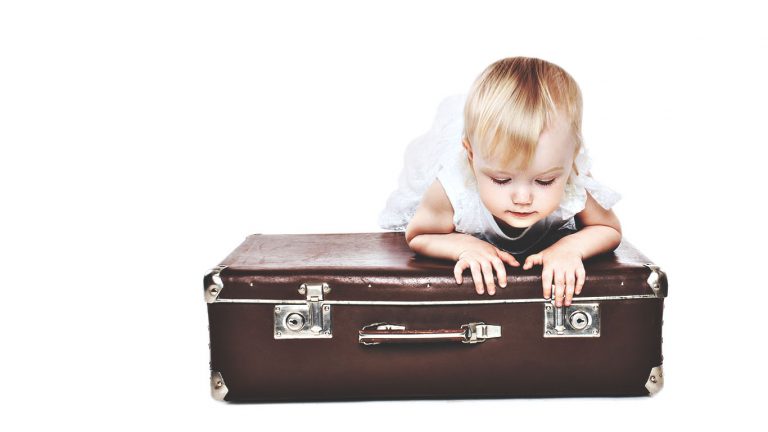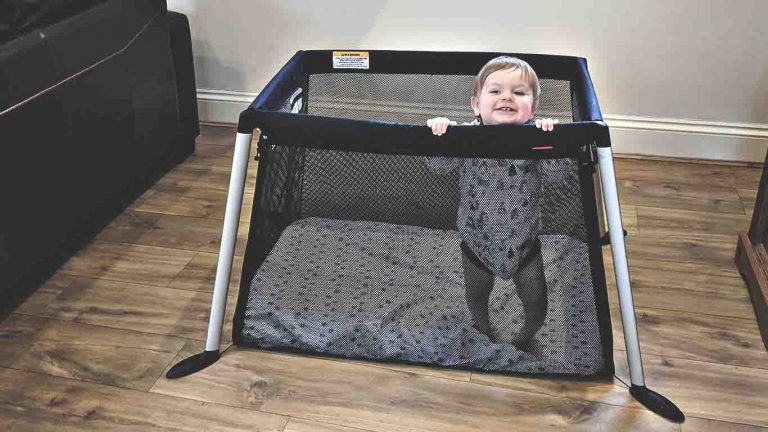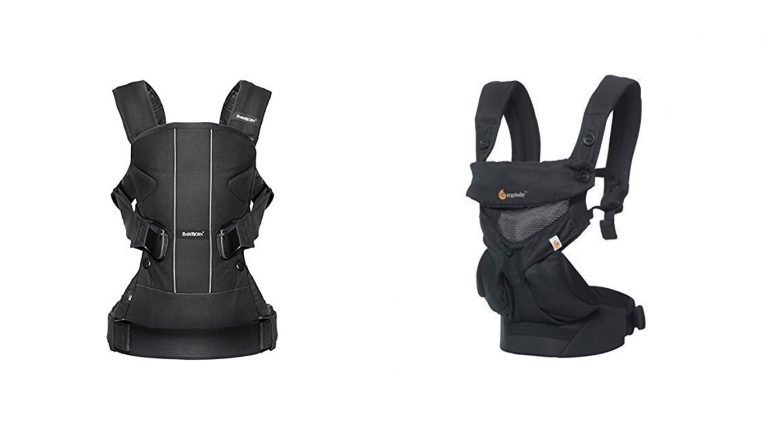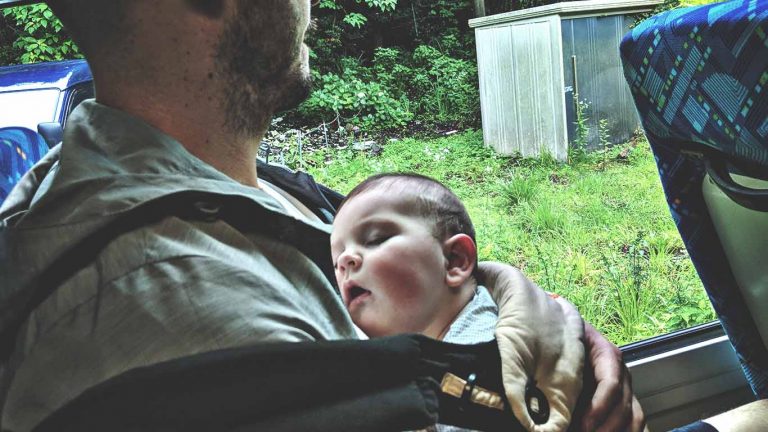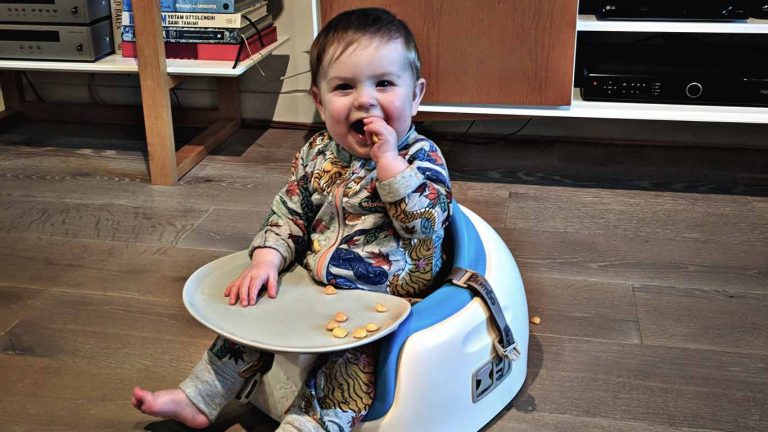Traveling with your kids means a lot of extra equipment. Among them is your child’s car seat, which is one of the trickiest travel accessories to choose and deal with. This will be even more confusing if it’s your first time traveling with a child.
You might have questions about the necessity of having a car seat, flight regulations, transporting the car seats, and which one to choose.
In this article, we will delve deep into all you need to know to be prepared. From rounding up some of the best travel car seats to explaining airline policies and more, we explain all that you need to know about travel car seats.
At a glance: Our top four choices for the best travel car seat:
- Best Overall Travel Car Seat – Safety 1st Guide 65 Convertible Car Seat
- Best Lightweight Car Seat – Cosco Scenera NEXT Car Seat OTTO
- Best Car Seat for Infants – Graco SnugRide 35 Infant Car Seat –
- Best Option for Older Kids – CARES Child Airplane Travel Harness
Top 7 Travel Car Seat Reviews for 2020
1. Safety 1st Guide 65 Convertible Car Seat – Best Overall Travel Car Seat –

Suitable For: 5 to 40 pounds for rear-facing & 22 to 65 pounds for front-facing.
As the title above suggests, the Safety 1st Convertible car seat is one of the best products you will find in the car seat market. In fact, it is one of the best-selling car seats; and for the right reasons.
Despite being slightly heavier than the Cosco Scnera car seat mentioned below, this car seat offers much more when it comes to overall value. In addition to the comfortable padding and secure latches on the seat, it is more versatile.
One of the best things about the car seat is that it is convertible. You can use this car seat straight from birth until your child approximately 65 pounds or 52” in height. It is light and slim enough to fit comfortably on most airplane seats and is FAA approved.
What We Like
- The seat is considerably lightweight at only 14 pounds, especially when compared to other models.
- There is also a removable cup holder on the side that can be useful for securing a bottle or sippy cup. You can detach it to save space while onboard.
- The seat is slim, measuring on 18 inches in width.
- The car seat is affordable enough to use without constantly worrying about any damage
- The car seat is convertible, meaning it can be used in both rear-facing and front-facing positions.
- The latches on the car seat are compatible for car use.
What We Don’t Like
- When using the car seat for a newborn, the straps on the seat can be hard to adjust properly.
- The padding can slip around a bit, especially when securing a smaller baby.
- You might need to add some more neck protection when using the car seat for a newborn baby.
2. Cosco Scenera NEXT Car Seat OTTO – Best Lightweight Car Seat

Suitable For: 5 to 40 pounds for rear-facing & 22 to 40 pounds for front-facing.
If there is any lightweight car seat worth the mention, it’s the Cosco Scenera Next. It is considered one of the best travel car seats that be used for newborns and toddlers as they grow.
It is a portable travel convertible car seat that boasts many of the features that the previous car seat has. The key element of the car seat is the lightweight design that makes it easy to carry and travel with.
You can use it as an airplane seat while onboard and then attach it to the backseat of a rental or cab when you reach your destination. The car seat is designed in a way that it can be used in most cars.
The design of the car seat is also FAA approved and TSA friendly. This means that you won’t have many problems moving it around the airport or getting through security.
What We Like
- The car seat weighs only 9.1 pounds, making it one of the lightest car seats to travel with.
- It’s only 17 inches wide and can be fitted into most airplane seats without much overhang.
- The car seat comes with a detachable cup holder that can be put away when not in use.
- The car seat is convertible and can be used in both rear-facing and forward-facing positions for children weighing up to 40 pounds.
- The car seat is also compatible with various transporters including a car seat backpack, making it even more travel-friendly.
What We Don’t Like
A narrower weight limit makes the car seat usable for babies only and not older kids over 40 pounds.
A cheaper price tag comes at the price of flimsier materials, popping off the seat easily.
The seat can be difficult to install, especially for new parents.
3. Graco SnugRide 35 Infant Car Seat – Best Car Seat for Infants

Suitable For: New babies from 4 pounds to toddlers weighing about 35 pounds
Having a newborn shouldn’t stop you from taking a trip that you had been planning before the little one’s arrival. Graco’s SnugRide car seat is one of the best travel car seats available for infants and smaller babies. This particular feature of the car seat is its claim to fame among traveling parents.
The overall design of the car seat, along with all its features, is meant to support infants. It’s incredibly lightweight at just 7.5 pounds and slim with a width of 18.5 inches. It’s convenient for carrying newborns and easy to fit in airplane seats.
It is highly advisable that you use the car seat in conjunction with the portable Graco stroller frame. The complete travel system is not only convenient in terms of compatibility but also ultra-lightweight weighing only 16 pounds.
Furthermore, the frame can be folded and tucked away in the overhead bin when you board the flight and attach the car seat to the airplane seat.
What We Like
- The lightweight of the car seat makes it a great choice for traveling with a newborn baby.
- The design of the car seat is approved by the FAA, making it compatible with most airplane seats.
- The car seat comes with a stay-in-car base that allows you just easily click the car seat in place.
- Can be used with the Graco stroller system for a great lightweight stroller travel system for traveling and at-home use.
What We Don’t Like
- Limited weight limits don’t allow the car seat to be used for older toddlers.
- The one-click base might be slightly unreliable, making it hard to take out the seat.
- The fabric used for the seat might not be comfortably breathable.
4. CARES Child Airplane Travel Harness – Best Option for Older Kids
Suitable For: Children 1 year and older, approximately weighing between 22 and 40 pounds and up to 40 inches tall.
The Cares travel harness is considered one of the best products for children older than a year old. This particular harness is even more lauded as it is the only harness-style product that has gained the approval of FAA. It is suitable for children a year old and up, weighing between 22 and 40 pounds.
One of the main advantages of the harness is that it is incredibly travel-friendly. Weighing just a pound, made of straps, and small in size, it can be tucked away in your carry-on luggage easily. You don’t need to get a transporter or a car seat bag to move it around the airport and the travel destination.
An important point to note about the CARES harness is that it is designed specifically for airplane travel. It is by no means approved for use in other types of vehicles.
What We Like
- The size is quite compact, fitting into a 6-inch sack easily.
- The CARES harness is approved by FAA for air travel.
- It allows for efficient installation, which takes less than one minute in total.
- The straps of the harness can be adjusted to fit most airplane seats, with the exception of pods and business-class seats.
What We Don’t Like
- It requires the child to sit up straight on the airplane seats, which can be difficult as most children are quite active during flights.
- The straps of the harness might be uncomfortable to sleep in.
- Without any cushioning, there is lack of neck and head support for the younger kids.
5. Evenflo Tribute LX Convertible Car Seat

Suitable For: 5 to 40 pounds for rear-facing & 22 to 40 pounds for front-facing.
If you’re looking for another lightweight alternative to the Cosco Scenera Next, Evenflo’s Tribute LX is a great option. At just 9 pounds, this is among the lightest car seats that are approved by the FAA for air travel.
In addition to that, the seat is 18.5 inches at its widest, meaning that it can fix into most airplane seats. In smaller seats, you can adjust the seat by lifting up the armrests.
The seat, much like others on this list, is convertible. This means it can be used for babies between 5 and 40 pounds.
Overall, the car seat is a great compact and lightweight alternative for travel. It will fit in most airplane seats and easily pass through baggage security and scanners. It is also a great car sear for other vehicles.
What We Like
- The car seat comes with ample padding and cushioning, keeping babies safe and comfortable, especially on long flights.
- The car seat weighs less than 10 pounds, making it easy to travel around with. In fact, you might not need a transporter to carry it around the airport.
- The car seat is compact enough to have 3 fit in the backseat of most cars.
What We Don’t Like
- The material used for constructing the body may feel very lightweight and cheap.
- The plastic can be flimsy.
- The straps on the car seat can be hard to adjust.
6. Cosco Apt 50 Convertible Car Seat

Suitable For: Up to 40 pounds for rear-facing & up to 50 pounds for front-facing.
If the Cosco Scenera Next is not available to you, the Apt 50 Convertible is another car seat option. However, the former is much better than the latter. Some parents would go as far as recommending investing in the Scenera Next instead of the Apt 50.
The ones who do choose this car seat do so because it is much more padded and cushioned. This allows your child to be more comfortable for the duration of the flight. One thing that could possibly cause a problem is the 22-inch width of the car seat.
Just to be on the safe side, ring up the airline and confirm if the size of the car seat will present any trouble fitting in the seats.
Overall, the car seat is a good alternative if other models are not available.
What We Like
- The car seat weighs only 9 pounds, making it one of the lightest car seats suitable for flying with.
- The car seat features a convertible design, making it suitable for babies and toddlers.
What We Don’t Like
- Being 22 inches at its widest part, the car seat can present some trouble fixing in narrower seats.
- You might have to have the armrests of your seat up to accommodate the carrier.
7. Graco Size4Me 65 Convertible Car Seat
Suitable For: 4 to 40 pounds for rear-facing & 20 to 65 pounds for front-facing.
Another incredible creation of the Graco brand, the Size4Me car seat is a great alternative to the Safety 1st car seat mentioned above. The main overlap between the two products is the weight limits and convertible nature.
Like the other products mentioned here, this car seat is also FAA approved. Despite having a larger width, the car seat is still compatible with most airplane seats. The base of the car seat has a narrow shape that can be adjusted without having to move the arm rests up.
What We Like
- The narrow design of the base of the car seat makes it easy to install in most airplane seats.
- The padding on the car seat and headrest is cushioned to keep your child’s head in a comfortable position.
- The car seat has a wider limit for usage as it can be used for newborns weighing just 4 pound all the way up to toddlers weighing 65 pounds.
What We Don’t Like
- Weighing 19 pound, the car seat is one of the heaviest, requiring a transporter or car seat backpack to move it around.
- The seat is 22 inches wide at the middle, making it difficult to situate in narrower seats.
Do you need to use a car seat on a plane?
When it comes to flying, this is probably one of the most controversial questions parents get. Some parents might agree to one while others disregard it completely. Let’s begin by focusing on what is necessary.
If you go by federal regulations, there are no specific aviation rules making the use of a car seat while flying mandatory. This is true for children of all ages.
Also, the Federal Aviation Administration also doesn’t require children under the age of two to be in separate seats. Many parents just choose to take their young children on flights as “lap children” to save money. It means that they carry the children in their laps for the entire length of the flight.
Based on the lack of regulations for very young children and infants, the decision to use a car seat on a flight is up to the parent’s discretion.
It’s debatable whether you should use one or not. The general agreement among most experts is to use an approved car seat. Young children are safest restrained in their own car seats in case there is heavy turbulence or a hard landing.
Despite not being compulsory, the FAA also recommends using a car seat or harness for children under 2 years of age and under 40 pounds in weight.
In the end, using a car seat or not is completely your call. Being the parent, you are in a position to make the best decision for your child. However, we do suggest considering some of the best travel car seats and using one for your young one.
The following pros and cons of using a travel car seat might be able to help you make the decision:
Pros of Using a Car Seat on a Plane
- The car seat will keep your child locked in place when the plane takes off or lands.
- Your child will be safer buckled in the seat in case of heavy flight turbulence.
- You don’t have to have your child in your laps and have enough space to relax and use your hands freely.
- It will help keep your child calm and provide some form of normalcy as they are used to being in their car seat.
- The seat will be able to keep your child comfortable and even allow them to sleep on the plane.
Cons of Using a Car Seat on a Plane
- Making your way through the airport, boarding the flight, and installing the car seat might be a hassle to deal with, especially for first-time travelers.
- Car seats are bulky, especially when you have other gear for your child with you.
- Children under 2 can travel for free if you carry them in your lap the entire flight. Using a carrier means booking another seat for the car seat to fit into. This may put a strain on your travel budget.
What are the rules for using a car seat on a plane?
When it comes to regulations on using car seats, the FAA has some recommendations. One of the main rules you need to follow is using a travel car seat approved by the FAA. If you have that in check, all you need to do is book a ticket for your child.
In this document, the FAA explains the requirements of a Child Restraint System (CSR) needs to comply with to get certified. Most major car seat manufacturers including Graco, CARES, Chicco, Cosco, and Britax among others are approved by the FAA.
The car seat should clearly say that “This Restrained is Certified for Use in Motor Vehicles and Aircraft” or something to that effect.
Brands from other countries are also allowed; provided that it shows approval of in-flight use. The approval should be issued by the government of the manufacturing company’s country. Or it should be approved under United Nations standards.
In order to prevent being grilled by a crew member, do take the car seat’s manual with you on the flight. It’s just a backup proof for the seat being approved by the FAA to be used onboard.
If the car seat you are using isn’t approved by the FAA or other foreign authorities, the airline company might not let you bring it onboard. Be sure to talk to your agent and/or look up the airline’s regulations on car seats before buying a car seat and booking the tickets.
Here are some other recommendations from the FAA pertaining to flying with car seats:
- The width of the car seat should be no more than 16 inches or wider than most airplane seats.
- Purchasing a ticket for your child is the only way to ensure you have a seat for the car seat on the plane.
- Book a window seat for the car seat to ensure it doesn’t block the way when passengers want to exit.
- If you haven’t purchased a ticket for your child, you can ask the airline if they will permit using an empty seat. If the policy allows it, book tickers for flights that typically not as busy.
- Place the car seat in a rear-facing position, especially if the manufacturer has specifically directed you to do so for certain weight or age limits.
Also, keep in mind that the rules for using car seats may vary from airline to airline and from country to country. If you’re traveling somewhere outside of the U.S., make sure to read up on the destination country’s regulations on using car seats for travel.
For instance, Australian airlines have varying rules for traveling with a car seat on a place. There are also some inconsistencies in rules about gate checking with a car seat.
In the U.S., car seats that are gate-checked can be picked up on the jet bridge when you land. This is not typical with Australian airlines. If you have any doubts, call the airline to check in car seat policies.
The same goes for foreign travelers making a trip to the U.S. Check the FAA’s website for further details on car seat requirements for flights.
How to install a car seat on an airplane
Each car is virtually similar in the way it is installed in a car or an airplane seat. The manual that it comes with will usually have a detailed step-by-step process explaining how it is installed properly.
You essentially install the car seat in an airplane seat the same way you would in a car. If you’re still unsure about how to go about that, the steps mentioned below might help give you some idea:
- Start by reclining the airplane seat just to the point that you have enough room to move around.
- Take both ends of the seatbelt and thread them through the bottom of the car seat.
- Clip the seatbelt together and buckle it tightly to the car seat is secure in its place.
- Once the car seat is sturdy, move the airplane seat back up enough to accommodate the car seat.
These steps should give sufficient explanation for most car seats. However, if you’re more of a visual learner, you can search for videos on YouTube that demonstrate how to install a car seat in a plane.
You can also find videos demonstrating the installation process of the specific brand you’re using.
When it comes to installation, there are some FAA regulations to keep in mind. For instance, car seats cannot be installed on aisle seats by the exit rows. This is mainly instructed so the car seat doesn’t impede if a passenger is trying to exit.
For children under 40 pounds, parents should face the car seat in a rear-facing position. If a flight attendant or another passenger asks you to turn the seat around, you are well within your rights to keep the car seat as it is. Provided your child fits under the guidelines pertaining to the weight and age limits.
Are you allowed to use booster seats on a plane?
The short answer to this question is no. The FAA doesn’t approve booster seats to be used in planes. The one exception to this rule is combination car seats.
These types of car seats typically have features that enable parents to use them with a 5 point harness or a seatbelt that is included with the seat. This is for when the seat is used in booster mode.
The seat should be approved for use on a plane as long as it can be used in a 5 point harness mode. Other than these types of car seats, most are not approved.
If a combination car seat is not readily available to you, you can use a low backed booster seat. These booster seats are small enough to be folded and stowed in the overhead bin. This way you won’t need to check the seat in.
There are various manufacturers who make booster seats specifically for children who are y years old or more and heavier than 40 pounds.
What to look for in a travel car seat
Most parents do their research when they are buying a car seat to use in their car. If they haven’t, looking for a travel car seat can be a bit more difficult.
Here are some basic points you need to consider when you’re shopping around for a car seat:
Approved by FAA
Before you even begin looking at other specs, features, and pros/cons of a particular car seat, make sure it is FAA approved. The travel car seat itself should have a sticker that clearly indicates that the car seat is approved by the FAA.
A flight attendant might ask to see the sticker when you’re boarding the flight.
Weight
The weight of the car seat will impact how cumbersome traveling with the CRS will be. A heavy car seat on top of the luggage and other baby gear that you need to carry can be too much to handle with a little one.
Make sure you look at the weight of the car seat whole shopping to make it is light enough to carry easily while traveling and keeps your baby safe and comfortable. Also, ensure that the manufacturer didn’t skimp on the passing to reduce the weight of the seat.
The best travel car seat should be under or just around 10 pounds. Trust us, you don’t want to lug around a 25 lbs car seat through the airport.
Width
The general rule of thumb is that the car seat should be wide enough to fit nicely in the airplane seat without being too large and bulky. The narrower the car seat, the better. The FAA recommends a width of 16 inches or less.
This can be difficult to follow as there are not many car seats available meeting this requirement. Most of the FAA-approved car seats are between 17 inches to 20 inches in width.
The good news is that the armrests on the car seats can be adjusted to create more space. Also, since the car seat is likely to be positioned in a window seat, the overlap will be on the parent’s seat.
Age range
As long as they are approved by the FAA, most bucker car seats considered suitable for infants can be used on planes. If your child is more on the toddler age spectrum, pay close attention to the age and size limits on travel car seats. Some of the best manufacturers have an upper limit of 40 pounds.
This usually includes children older between 2 and 4 years of age.
Tips for traveling with a car seat
Traveling with children is a challenge itself. When you add a travel car seat to the equation, traveling seems even more of a task. Not only do you have to keep your child safe and comfortable but also be efficient in making your way on the flight.
Here are some tips that can help you manage your next family vacation a bit better
1. Research the airline’s car seat width limits
Flying with a car seat that doesn’t properly fit into the airplane seat can be very inconvenient. To avoid being stuck with this dilemma, check-in with the airline to find out the seat measurements ahead of the flight.
2. An all-in-one stroller system
Car seat manufacturers like Graco make all-in-one stroller systems that have an attachable car seat. They can make traveling much lighter as you won’t need to carry a car seat and a stroller separately.
You can use the stroller to move everything around the airport and then detach the car seat once you have to board the flight. You can check in the stroller and then take the car seat on board.
3. Consider renting a car seat at your destination location
This is mostly aimed at toddlers who don’t particularly need a CRS on the flight. This way you don’t have to make an expensive purchase you won’t particularly need on the flight.
You can consider renting a car seat or stroller at your travel destination. Car rentals at the airport also offer car seats that you can use for the duration of stay, lowering the expense of having to purchase one.
4. Invest in a car seat travel cart
Whether the car seat is 10 pounds or lighter, carrying it with your child still in it, can get tiring really quickly. To make things lighter on your arms and muscles, consider buying a car seat travel cart. This will make your life easier, especially if you’re not planning to take a stroller with you.
You can attach the car seat to the cart and your child can ride it. You can fold them and chick them in the overhead compartment when you’ve boarded the flight.
If you don’t want to buy a cart, you can consider getting a car seat travel belt. This allows you to attach the car seat to your suitcase. However, your child will not be able to sit in the seat if you’re using a belt.
Car seat travel carts and transporters to help you get through the airport
If you give the last tip mentioned above a whirl, here are some of the most popular car seat travel carts you can choose from:
1. Britax car seat travel cart

This travel cart features latch connectors that secure the car seat onto the base of the cart. The connectors are the same as the ones that connect the car seat to your car.
The cart is made of durable steel and has a raised platform that keeps the car seat off the ground quite sturdily. The frame also has two telescopic handles that can be adjusted to two positions.
It is 5.5 x 13.5 x 42 inches in size and has a foldable body that can be easily fitted in an overhead compartment.
2. J.L. Childress Ultimate Backpack Padded Car Seat Travel Bag

While the other two transporters are similar to a foldable stroller, this J.L. product allows you to carry the car seat like a backpack. It fits both infant and toddler car seats and is certified for air travel.
The travel bag features harness-style, padded straps that hoist the car seat higher on your back. This reduces the strain on your back, neck, and shoulders. It bag also features padded wings on the interior to protect the car seat’s safety features.
Final Thoughts
When it comes to the best travel car seats, the Safety 1st Convertible car seat is the clear winner. Despite a bit heavier compared to other alternatives, it comes out to be more convenient and versatile. In fact, it can last you until your child until they weigh 65 pounds.
It is also compatible with the transporters mentioned in the article, allowing you to be hands-free while moving around the airport.
With all the care that goes into traveling comfortably with your child, the Safety 1st is well worth the investment. Your little one will be safe and secure, giving you some time to be hands-free and maybe even enjoy the flight.


